Grazing Systems
More than one way to keep a horse
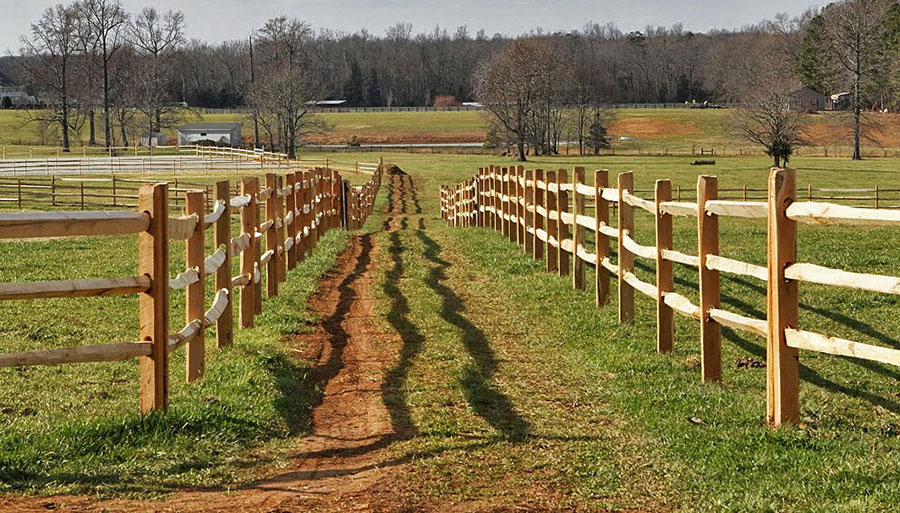
Different approaches to keeping horses at grass can improve the health of the animals and the land.
Managing a horses environment can be pivotal in barefoot performance. There are many different systems of arranging the environment, each with their own merits, considerations, and objectives.
Continuous Grazing (24/7 in the same paddock)
Grazing the same paddock 24/7, 365 days a year, is known as continuous grazing. The paddock size can be small, such as an allocated field at livery, or a large field just for yourself. The key point is that the horses are always on it, regardless of time of year.

Continuously grazed pastures are overgrazed in certain areas, and ungrazed in the toilet areas, with constant trampling
Horses are selective grazers - they will generally find the best tasting patch of grass, and eat. And eat, and eat and eat. This means that the pasture does not get evenly grazed, but instead is overgrazed in some areas and left untouched in others, resulting in the pasture having a "patchy" appearance.
Furthermore, the desired forage species will have been eaten, whilst uneaten species flourish. This applies to paddocks that are small or large, with the only difference being the size of the grazed/ungrazed patches.
This is quite a common environment for horses at grass livery, where an allocated patch of land is supplied for sole use.
Benefits
- Easy to implement - only a boundary fence is needed
Considerations
- Forage isn't given a chance to rest
- Soil is constantly trampled under foot
- Gateways/water trough areas are likely to be bare in the summer and mud in the winter
- Parasite infection is at high risk, as horses graze around toilet areas
- Toilet areas will be uneaten, whilst overgrazed pasture is discouraged from recovery - leading to loss of edible forage and encouragement of unedible weeds
- Does not encourage biodiversity, as the most palatable forage species will be eaten the most, typically to their extinction
- No chance to mow, reseed, or treat pasture with horses always on it
Strip Grazing
Strip grazing is a technique where the paddock boundary is moved little and often, revealing a fresh "strip" of grass.
Typically used to limit grazing on larger paddocks, it is a good way of maintaining weight or managing those with metabolic issues during sensitive times, such as spring.
Some strip grazing systems move two boundary fences, so that as a new strip of ground is revealed, an equivalent amount is taken away, thereby allowing a period of rest for the grazed pasture. This also keeps the paddock size consistent, without it gradually increasing over time.
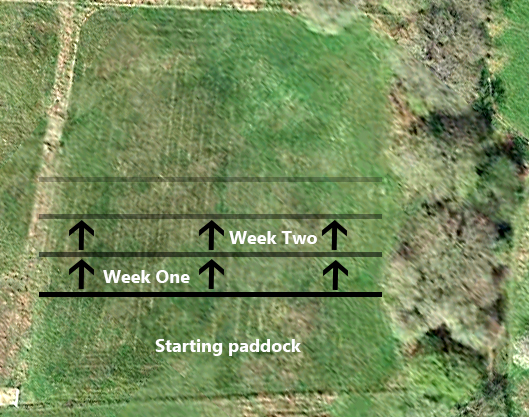
Single-fence strip grazing, where the fence is moved every week to gradually increase grazing paddock size. The grazed paddock is not rested.
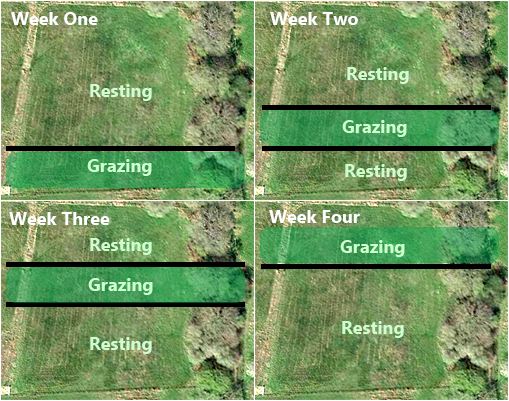
Dual-fence strip grazing, where two fences are moved at the same time over a 4 week period, allowing previously grazed areas to rest
Benefits
- Controls the amount of pasture provided
- Allows larger amounts of the paddock to rest, so increases productivity for the near-future
- Supplies newer grass in restriced amounts, so fresh grazing is trickle-introduced to the horses system
- Horses are given fresh pasture regularly
- The two fence approach rests an equal amount of pasture as more is provided
- Minimises selective grazing
- Minimises over grazing
Considerations
- Will need more electric fencing equipment
- More labour intensive - such as moving fencing (possibly the water source too)
- Horses are kept in smaller paddocks, so not as much room to roam or canter
Rotational Grazing
Giving a paddock a period of rest is greatly beneficial in rejuvenating grazed pasture. Dividing a paddock into two or three separate lots can improve the health of the pasture by preventing overgrazing and allowing management to be done on fenced-off paddocks. The rest period also hinders the competition from weeds that would overtake pastures that have been overgrazed.
The period of rotation can be anywhere from a several days to several weeks, depending on how much land is available.
Clever design of the lots means that shelters or hard standing areas can be shared regardless of the lot the horses are in.
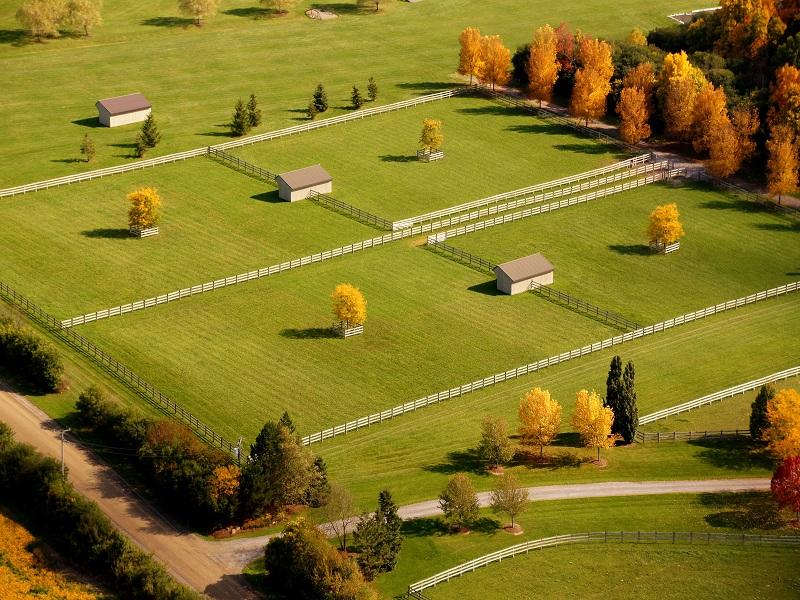
Four individual paddocks with 2 shared shelters
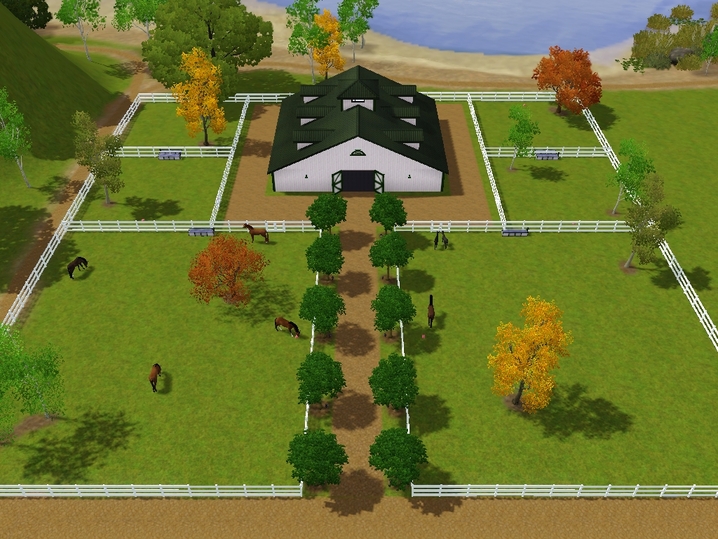
Paddocks with a central stable block
Benefits
- Pasture is given a chance to rest. This allows regrowth, increasing pasture productivity
- Reduces overgrazing of the most palatable grass species
- Reduces weed infiltation
- Reduces trampling and soil compaction
- Allows for management of an individual paddock without the horses being in it
Considerations
- More fencing, gates, and watering points may be needed
- ...but these can be shared between paddocks
- Requires more involvement and decisions based on current pasture health
- May be harder to provide shelter to every paddock
Paddock Paradise (aka Track Systems)
Also known in the UK as Track Systems, the concept was championed by Jaime Jackson in an effort to mimic the environment and feeding habits of wild/ feral horses he observed in the Great Basins of America.
"A PP will encourage movement even on small acreages. It allows horses to live more closely to the manner nature intended, moving freely 24/7 and eating in a more natural way by having constant access to the right kinds of food placed strategically throughout their track."

Paddock Paradise in Finland, incorporating different surfaces to condition feet daily. Image courtesy of AANHCP
"The principal goal of PP is to facilitate health and soundness - both physical and mental - in our horses."
A paddock is divided into lanes, or a track around the outskirts of the field, and the horse moves around the track whilst grazing.
Grass is generally limited, either through choice or the gradual reduction of species through trampling and over grazing. This is an important element of Paddock Paradise, as if the grass was long enough, the horses would not move as much to find the next mouthful. As such, people who use a track system generally supplement hay daily, placing it at positions around the track to encourage movement.
The grass that the horse is not grazing (in the middle of the track) can be hayed, or saved as foggage for the winter.
One of the best examples i have found on the internet of a track system being proved to increase movement vs. conventional grazing approaches is outlined on the Dutch Hollow Acres site. Confirmed by GPS, they showed how the distance their horses typically travelled more than doubled from 1.41 miles per day to 3 miles per day, when loose hay was distributed around the track. That is over 100% more movement, and therefore exercise, that the horse is doing.
Rockley Farm also uses a track as part of it's approach to rehabilitation.
Track-based livery is starting to increase in popularity and availability, a great example of which is Graveney Natural Track Livery (with a popular facebook group too).
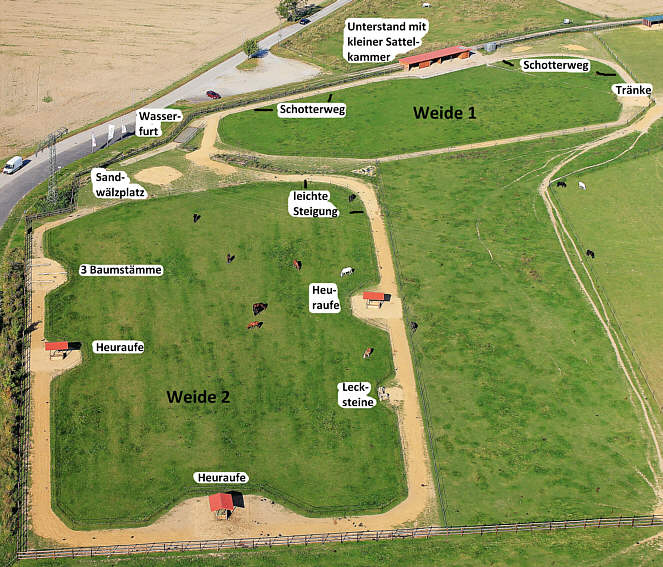
Aerial view of a large track in Germany
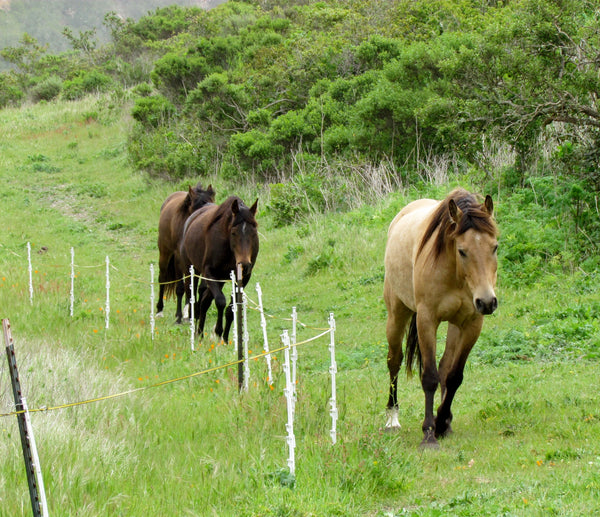
Image courtesy of Jill Willis from AANHCP
Benefits
- Repeated movement over all-weather surfaces, such as sand and gravel, can greatly improve hoof health
- Reduced grass availability may be a good solution for metabolic or grass-sensitive horses, to have exercise and freedom whilst restricting access to pasture
- Can massively increase daily exercise
- A good way of increasing movement whilst restricting grazing during the summer months.
- Increase movement on smaller paddocks
- Tends to encourage faster movement (trot and canter)
- Creativity can lead to a very interesting environment for horses, incorporating different surfaces, slopes, trees, watering holes etc.
Considerations
- You may need the appropriate council permissions to lay down a year-round, all-weather track
- The cost of adding aggregates to the track can be substantial
- Encourages soil compaction and reduction of grass species on the track
- Can get seriously muddy in the winter without the use of all-weather surfaces
- Increased feeding of hay, possibly ad-lib
- A lot of fencing equipment will be needed
Equicentral System
A concept developed by Jane & Stuart Myers of Equiculture, the Equicentral System focuses on a natural environment for horses that maximises pasture health.
They found that horses have grazing "bouts" that last for around 3 hours, then typically change their behaviour ie drink, socialise, loaf. This approach encourages all non-grazing activities to be done off the pasture on a central yard, where the water troughs, hay feeders, shelter are located.
A basic equicentral approach, showing 4 paddocks with a central loafing area that every paddock has access to, where shelter, hay and water is located
In this approach, rotational grazing is used to keep horses off the pasture until it is around 8 inches tall, and then grazed upon until it's around 2 to 3 inches tall. At this point, the horses are removed from the pasture until it has regrown to around 8 inches again. This gives the pasture chance to recover from previous grazing bouts, but more importantly, provides forage that is higher in fibre than short grass.
The horses are able to choose when they graze, and allowing unrestricted access to pasture prevents behaviour often found in forage-restricted horses, such as gorging when returned (or escaped!) onto pasture.
Soil health is at the centre of this approach. By optimising soil health, everything connected to it will also improve in health. The relationship between plant roots and naturally occuring funghi in the soil (the mycorrhizas) are dependant upon the health of the soil - so resting, rotating, and spreading manure, will all improve the soil health, and therefore pasture health.
The healthier the pasture, the healthier the horse.
This approach works well with Dr Juliet Getty's principles of constant forage access leading to intake regulation, and in some cases (through careful monitoring), the reversal of metabolic issues that may have forced an owner into keeping a horse on short, stressed grass - conditions that according to Dr Getty, may preclude and even create the metabolic disorder to begin with.
Benefits
- All of the benefits of rotational grazing
- Having a central yard also works well with strip grazing
- Avoids grazing restriction; horses eat as they like, when they like, where they like
- Horses are not kept in muddy fields or waiting at muddy gateways
- Looking after the pasture improves it's health and productivity. Improvements in soil health and biodiversity have a positive impact on horse health.
- Horses can choose their environment when it suits them e.g. they can seek shelter when it's hot, then have a grazing bout, before going back to the yard area for a nap.
- Many existing facilities can be incorporated to use this system - it is just the way that they are used that is different. As such, it can be very cost-effective with good results.
- Works well on rented land, where a landowner may be happier to allow permissions for setting up the system, as it does not degrade the land but instead enhances it.
Considerations
- Described as an "upward spiral", the first year of implementing this system is often the hardest before improvements in the pasture are noticed
- The focus on pasture health means that horses may need to be removed from pasture when it is too short to graze. In extreme cases, horses may need to be kept on the yard with ad-lib forage until the pasture recovers enough to allow them back on it.
Cell Grazing (aka Mob Grazing and Managed Intensive Grazing)
Initially, cell grazing appears quite similar to rotational grazing. However, a cell system follows at least 3 of these 6 principles:
- Control rest to suit the growth rate of the plant
- Adjust stocking rate to match carrying capacity
- Plan, monitor and manage the grazing
- Use short graze periods to increase animal performance
- Use maximum stock density for the minimum time
- Use diversity of plants and animals to improve ecological health
- Use large mob size to encourage herding1
The most common approach, time-limited cell grazing, turns the horses onto a new grazing cell every day or two. A small cell has a high number of horses in it, for a brief period of time, before they are removed onto a new cell shortly after. Horses are turned onto new cells as frequently as possible, sometimes rotated to different paddocks on the same day.
Grazing cells do not have to be small, although the smaller they are the shorter amount of time the horses spend in it. Cells also avoid "bare dirt" paddocks from overgrazing, and aims for there to always be a ground covering of forage.

Benefits
- All the benefits of rotational grazing
- High stocking rate and a short timescale before moving to another cell means that picking manure is not required - it is encouraged not to pick poo, so that the ground is naturally fertilised.
- Frequent rotation means the pasture is rested often, so minimises poaching and compaction.
Considerations
- All the resources a horse needs has to be available in every cell, such as shelter, water etc. This may need considered paddock design.
But What's Right For Me?
The environment you use is largely determined by your situation. With appropriate permissions you have much more freedom and flexibility to create a more stimulating environment. However, even without permissions, you can still very easily take elements of a system and incorporate what you can.
For instance, rotational grazing can be achieved by simply dividing your pasture with electric tape into three paddocks. If the horses are kept on each paddock for 2 weeks, then that means each paddock is rested for 4 weeks.
You may find that you use one of the above systems only when the need arises. For instance, using strip-grazing when recovering from an injury or to manage a metabolic issue.
If you already have a barefoot horse and have improvements in the foot have reached a plateau, or you do not have the time to exercise the horse enough, then systems that incorporate surfaces can improve the foot whilst you are at work, at home etc. Setting up this kind of environment before you transition to barefoot will greatly accelerate the transitional process and result in a healthier foot much quicker.
Further Reading
Rotational Grazing for Michigan Horses, Karen Waite, MSU Extension, January 2014Grazing Systems, Buckingham, McCalman & Powell, IBERS Grassland Development Centre, Farming Connect, February 2013
Manure and Pasture Management for Horse Owners: Better Management of Your Horse's Pasture, Alberta Agriculture & Forestry
Grazing Strategies for Horse Pastures, Lori K. Warren, PhD Extension Equine Specialist, Colorado State University
What is Management-intensive Grazing (MiG) and what can it do for my farm?
www.onpasture.com - a great resource for all grazing related articles
References
1)Cell Grazing - The First 10 Years in Australia by Terry McCosker, published in Tropical Grasslands (2000) Volume 34, 207-218
2)Managing Established Horse Pastures Krishona Martinson PhD & Paul Peterson PhD, University of Minnesota